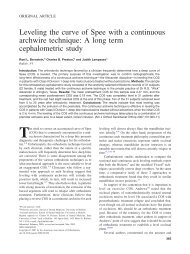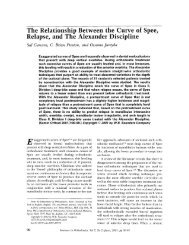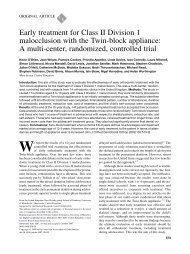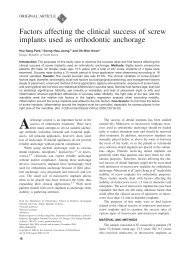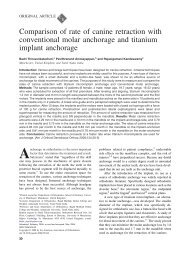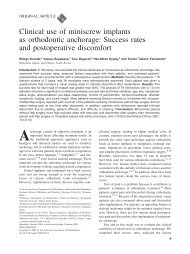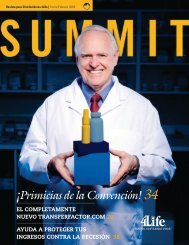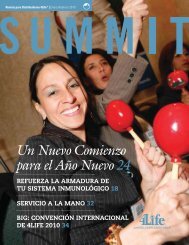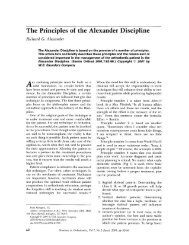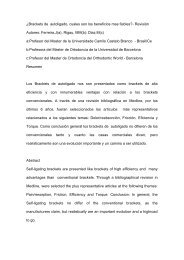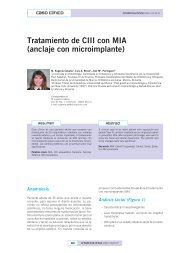Biomechanical and histological comparison of self-drilling and self ...
Biomechanical and histological comparison of self-drilling and self ...
Biomechanical and histological comparison of self-drilling and self ...
Create successful ePaper yourself
Turn your PDF publications into a flip-book with our unique Google optimized e-Paper software.
American Journal <strong>of</strong> Orthodontics <strong>and</strong> Dent<strong>of</strong>acial Orthopedics<br />
Volume 133, Number 1<br />
(PIT) <strong>and</strong> peak removal torque (PRT) in an animal<br />
model, <strong>and</strong> to investigate the influence <strong>of</strong> <strong>self</strong>-<strong>drilling</strong><br />
<strong>and</strong> <strong>self</strong>-tapping techniques on BIC values under orthodontic<br />
force.<br />
MATERIALS AND METHODS<br />
Two adult female mongrel dogs (weight, 13 kg)<br />
were housed in the animal laboratory at Kyungpook<br />
National University Medical College in Daegu, Korea.<br />
All permanent teeth were erupted, <strong>and</strong> maxillary <strong>and</strong><br />
m<strong>and</strong>ibular growth was completed. The treatment <strong>of</strong> the<br />
experimental animals was approved by the ethics committee<br />
<strong>of</strong> the Medical College at Kyungpook National<br />
University.<br />
Fifty-six threaded microimplants (Absoanchor,<br />
Dentos, Daegu, Korea) made <strong>of</strong> titanium alloy (titanium,<br />
aluminum, vanadium) were used for this experiment<br />
<strong>and</strong> divided into 2 groups. The head <strong>of</strong> the<br />
microimplant was hexagonal to enable placement with<br />
h<strong>and</strong>-driver; it had a small hole for threads <strong>and</strong> ligature<br />
wires. SDIs, with a specially designed sharp tip <strong>of</strong><br />
conical shape with threads, served as the study group,<br />
<strong>and</strong> STIs with an ordinary tip served as the control<br />
group (28 for each group). Size 1312-07—tapered with<br />
1.3 mm neck diameter, 1.2 mm diameter near the apex,<br />
<strong>and</strong> threaded intrabone part 7 mm—was chosen for this<br />
experiment (Fig 1). The 2 types <strong>of</strong> microimplants were<br />
the same size <strong>and</strong> shape (except for the tip), had the<br />
same placement angle <strong>and</strong> similar force magnitudes,<br />
<strong>and</strong> were intended for similar bone densities.<br />
The buccal side <strong>of</strong> the bilateral maxilla <strong>and</strong> m<strong>and</strong>ible<br />
<strong>of</strong> the dogs was chosen as the recipient site for<br />
symmetrically placing 2 groups <strong>of</strong> microimplants. The<br />
left side was for SDIs, <strong>and</strong> the right side was for STIs<br />
Chen, Shin, <strong>and</strong> Kyung 45<br />
Fig 1. Microimplants <strong>and</strong> h<strong>and</strong>-driver used in this<br />
study: A, STI with tip; B, SDI with tip; C, microimplant<br />
head; D, h<strong>and</strong>-driver.<br />
head <strong>of</strong> the microimplant remained outside the attached<br />
gingiva for connecting the nickel-titanium springs (Fig 2).<br />
Twenty-eight STIs were placed with the <strong>self</strong>-tapping<br />
method. A pilot hole was drilled first with a<br />
0.9-mm diameter round bur, as deep as the length <strong>of</strong><br />
in 1 dog (Fig 2). The left maxilla <strong>and</strong> the right m<strong>and</strong>iblemicroimplant<br />
thread part, with a h<strong>and</strong>piece at a speed<br />
received SDIs, <strong>and</strong> the right maxilla <strong>and</strong> the left <strong>of</strong> 500 rpm by <strong>drilling</strong> intermittently. Saline solution<br />
m<strong>and</strong>ible received STIs in the other dog. All microim- was used to keep the bur <strong>and</strong> drill cooled <strong>and</strong> the<br />
plant placement procedures were performed aseptically placement site lubricated. Then the microimplants were<br />
with a 90° implant placement angle to the long axis <strong>of</strong> manually placed with the same long h<strong>and</strong>-driver, ac-<br />
the teeth. Oral hygiene was achieved by rinsing each<br />
20<br />
cording to the technique described by Kyung et al.<br />
dog’s mouth biweekly with 0.2% chlorhexidine glu- Approximately 200 g <strong>of</strong> continuous <strong>and</strong> constant<br />
conate solution.<br />
horizontal force was immediately applied by stretching<br />
For the placement <strong>of</strong> the microimplants, the dogs nickel-titanium superelastic closed-coil springs (Tomy,<br />
were anesthetized with a cocktail composed <strong>of</strong> ket- Tokyo, Japan) between 2 microimplants for 9 weeks (Fig<br />
amine (Ketara; Yuhan, Seoul, Korea) at a dose <strong>of</strong> 10 2). The springs contacted the microimplants directly.<br />
mg per kilogram <strong>of</strong> body weight, xylazine (Rompun An operator who has placed more than 100 microim-<br />
Bayer Korea, Seoul, Korea) at 0.4 mg per kilogram <strong>of</strong> plants in patients <strong>and</strong> for animal experiments placed all<br />
body weight, <strong>and</strong> saline solution.<br />
the microimplants.<br />
Twenty-eight SDIs were placed with the <strong>self</strong>-drill- PIT—the force <strong>of</strong> the maximum clockwise moveing<br />
method. They were manually placed through the ment that stripped bone from screw insertion until it<br />
attached gingiva with a long h<strong>and</strong>-driver (Dentos, was perfectly placed—was measured with a precision<br />
Daegu, Korea) that was especially designed for these digital indicator (EMT, E-mobile tech 17000 series;<br />
microimplants, without pilot <strong>drilling</strong> <strong>and</strong> incision. The SEEC, Seoul, Korea) <strong>drilling</strong> after placement for all



